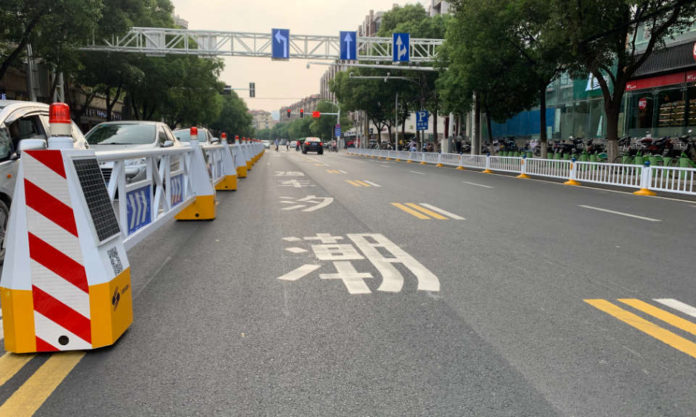
Traffic in opposing lanes is often separated by barriers, but who says they have to remain stationary? Nanjing is blazing the way forward for smart city roads, as an automatic tidal lane has entered operation that helps considerably to ease rush hour congestion.
The tidal lane went on duty yesterday morning on Jinsheng Lu in Nanjing’s Jiangning District, occupying just 60 metres of road between Bian’an Jie and Zhongshui Lu. As in many parts of Nanjing, traffic here flows predominantly into town in the morning and out of town in the evening.
- Man unplugs traffic light to charge mobile phone
- Nanjing Ring 1.5 Mystery; What Kind of Name is that for a Road?
The concept of tidal lanes is hardly new. Many cities all over the world have them in in one form or another. That they be automatic, however, is decidedly unusual. Other than Nanjing, on the Mediterranean island of Malta, for example, a road has bollards that raise and lower themselves to direct traffic into and out of a tidal lane.
The nature of Nanjing’s automated tidal lane means that it need be solar powered. According to Nanjing Daily, the powered barrier can go for 15 days on a single charge.
The system, however inspiring, is hardly foolproof. Traffic police officers are required to block the lane to traffic in the seconds prior to operation.
While the tidal lane performed its duty today, 26 May, at 7am and 4.30pm, an officer on duty told The Nanjinger that the times may be adjusted depending on traffic conditions each day.
This section of Jinsheng Lu has been chosen for this first smart piece of Nanjing road on account that there are 14 residential communities nearby, with a resident population of 78,000. Jinsheng Road is virtually the only route that the communities have for entry and exit.
According to the statistics aggregated thanks to big data, morning According to the statistics aggregated thanks to big data, morning westbound traffic is 1,122 vehicles per hour, some 2.3 times that of eastbound traffic. As for the evening, the eastbound peak is 798 vehicles per hour, which is 1.9 times that of the westbound.
After its first day of operation, Jiangning Traffic Police learned that the tidal lane helped increase the average speed of vehicles by 32 percent, while overall efficiency of traffic along Jinsheng Lu is up 36.5 percent.

